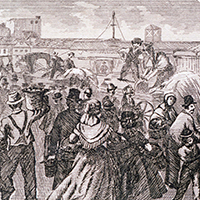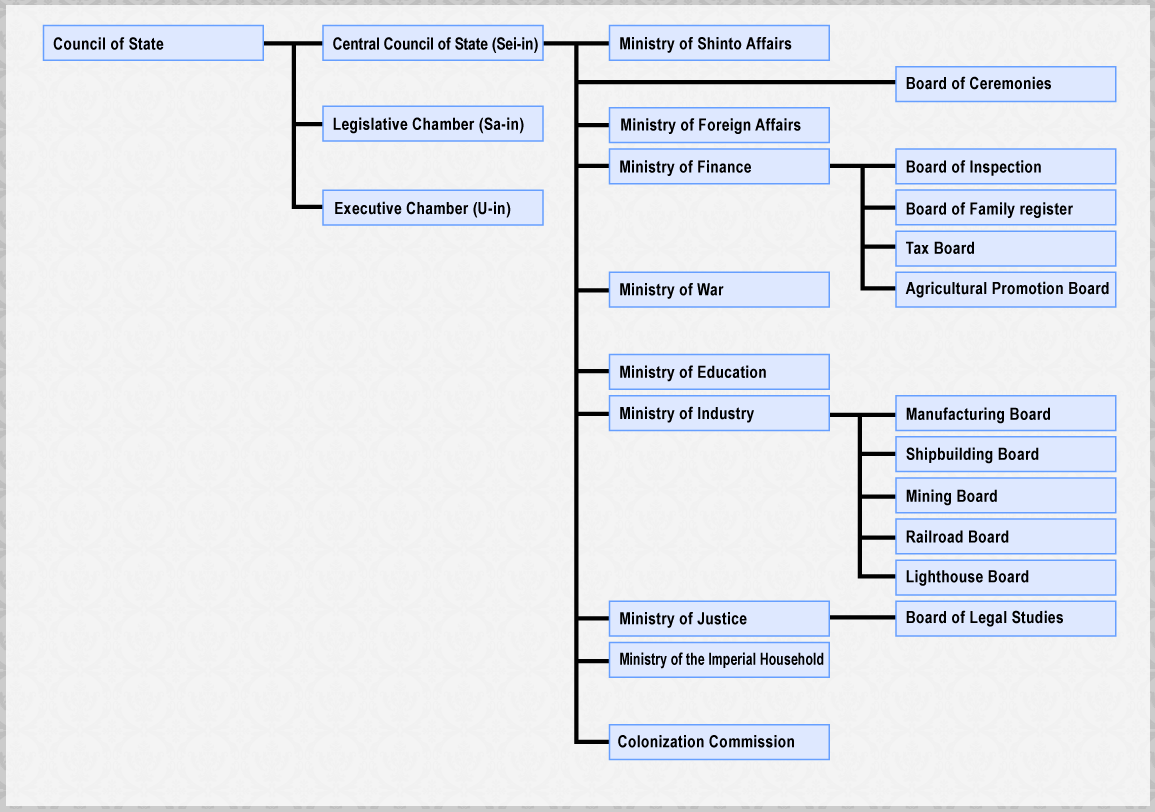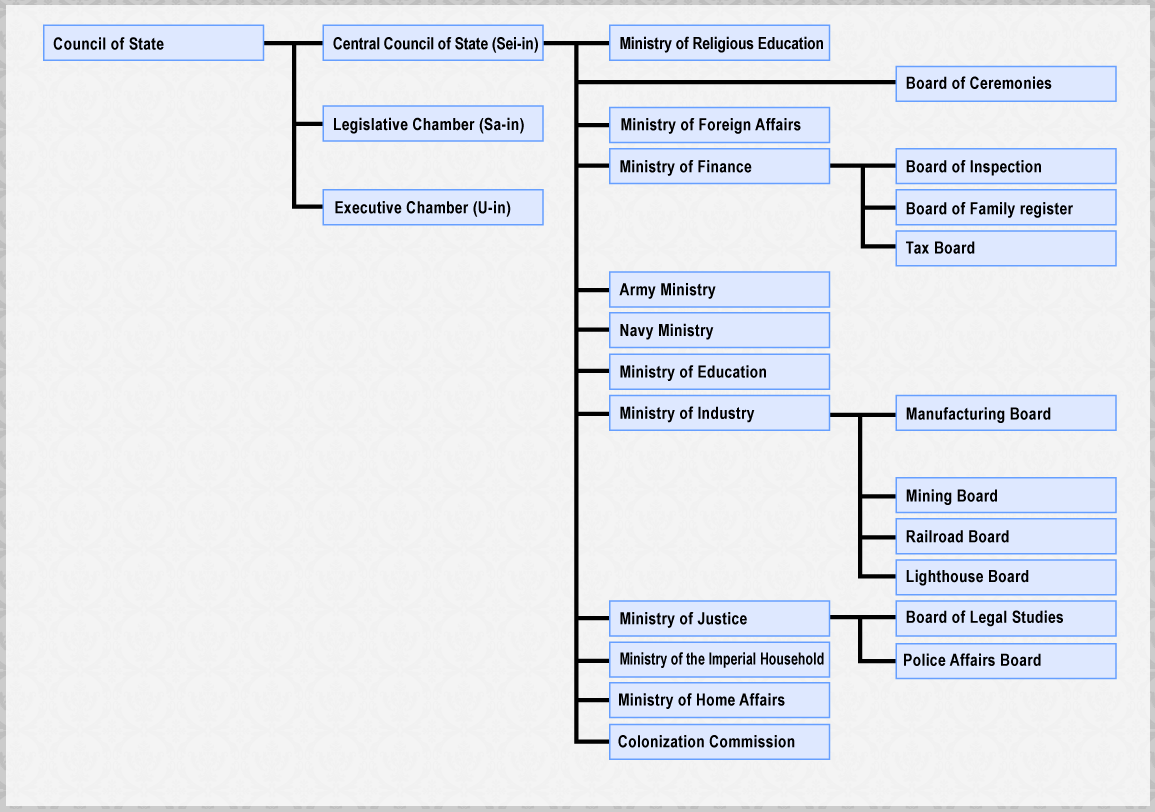| Council of State | The central institution of the Meiji government. All power was assigned to the Council of State under the central government reorganization of June 1868. The body contained within it a number of Ministry (Kan)--later renamed Ministry (Sho)--that were to engage in administrative affairs. A three-council system was introduced in the reforms of September 1871 that created a Central Council of State to oversee the ministries, a Legislative Chamber (Sa-in) for reviewing and deliberating legislation, and an Executive Chamber (U-in) to coordinate among the ministries' differeing interests. |
| Central Council of State (Sei-in) | Established in September 1871, this was the highest decision-making body of the Council of State. The Grand Minister and Ministers of the Right/Left advised the Emperor, while the State Councilor carried out administrative functions. The Central Council of State (Sei-in) employed an Administrative Officer (Naishi) who drafted or managed documents within the Central Council of State (Sei-in), and a Liaison Officer (Gaishi) who distributed documents to each ministry and prefectures. |
Ministry of Shinto Affairs | Central goverment ministry created in September 1871 to oversee policy on proselytization and edification regarding national religious rites and Shinto affairs. Its duties were set down as handling matters concerning rituals and religious indoctrination based on the principle of the unity of rites and rule, though in actual fact its main project turned out to be preparing and carrying out the Daijo-sai harvest festival held in December 1871 to mark the Meiji emperor's enthronement. The ministry was abolished in April 1872. The Board of Ceremonies took over the ministry's responsibilities regarding rites and rituals, while the Ministry of Religious Education assumed its responsibilities regarding proselytization and edification. |
| Board of Ceremonies | Established in September 1871, this Council of State department handled matters related to religious rites and ceremonies. Initially, in addition to its oversight of religious rites and ceremonies at the imperial court, this body also oversaw matters related to traditional Court music (gagaku). When the Ministry of Shinto Affairs was abolished in April 1872, the Board of Ceremonies inherited some of its duties and became an institution that focused exclusively on religious rites. |
| Ministry of Foreign Affairs | Central goverment ministry with responsibility for foreign policy and government-related business overseas. Established in the central government organizational reforms of August 1869, its duties were initially to supervise diplomatic affairs and trade with foreign countries. However, preparing the department that would fulfill this role took until January 1873. While that work was going on, the government created the Enryokan (reception facilities) (1869), established diplomatic facilities abroad and staffed them with Charges d'Affaires (1870), and founded the Lanugage Education Insitute (1871). |
| Ministry of Finance | Central government ministry resonsible for handling matters related to public finance. Established in the central government reorganization of August 1869, its roles were set down as handling the expenditure and receipt of money and related articles as well as the production of currency. From the outset, the minister and vice-minister concurrently also held those posts at the Ministry of Civil Affairs. The two ministries were subsequently consolidated, with the result that the authority of the minister and vice-minister extended to all matters of domestic administration. This drew criticism from both within the government and outside parties, so in August 1870 the roles of the two ministries were separated. However, when the Ministry of Civil Affairs was abolished in September 1871, the Ministry of Finance took over its portfolio and once again held enormous power. |
| Board of Inspection | Established in September 1871, this department of the Ministry of Finance was responsible for inspecting public accounts. Its role was to determine the propriety of expenditures and receipts of money and related articles. In January 1877, it was reorganized as the Inspection Bureau. |
| Board of Family register | Ministry of Finance department established in September 1871 to oversee the family register system. The Family Registration Act had been promulgated that year ordering that Jinshin-koseki (family registers) be compiled, a task assigned to the new board. In January 1874, the department was transferred to the newly established Ministry of Home Affairs. |
| Tax Board | Ministry of Finance department established in September 1871 to handle taxation administrative affairs. In addition to assessing taxes, it also handled matters related to land and was granted jurisdiction over Land Tax Reform Office established in August 1872. In January 1877, the Board was reorganized to become the Land Tax Bureau. |
| Agricultural Promotion Board | Ministry of Finance department charged with encouraging development in the agricultural sector. An Industrial Promotion Board had been created in the ministry in September 1871, and shortly thereafter it was renamed the Agricultural Promotion Board. The Board worked to advance agriculture mainly in the areas wasteland reclamation and livestock production. It was abolished in November 1872. |
| Ministry of War | Ministry responsible for military affairs and maintaining public order, created after government institutions were reorganized in August 1869. The ministry furthered the creation of armed forces that would be under direct control of the Meiji government. The army and the navy were not separate branches at first, nor were military administration and military command separate. In September 1871, the government created an Army Division and a Navy Division, as well as the Army Staff Bureau. The ministry was abolished in April 1872, to be replaced by the newly founded Army Ministry and Navy Ministry. |
| Ministry of Education | Ministry responsible for administering education and cultural affairs, established in September 1871. The ministry consolidated schools that already existed around the country including such institutions as Daigaku Nanko (Western Learning College) and Daigaku Toko (Medical College) with the goal of creating a uniform educational system. |
| Ministry of Industry | Ministry responsible for government policies to encourage new industries. Established in December 1870. The ministry had jurisdiction over providing incentives to private industry and the operation of government enterprises--core activities in this area being railroad construction and mine development-- with the objectives of bringing Western technology and industry into Japan. |
| Manufacturing Board | Ministry of Industry department responsible for manufacturing machinery. Established in September 1871. The ministry absorbed the duties of the Shipbuilding and Iron Manufacturing Board in November 1872, the Industry Promotion Boardin November 1873, and the maintenance and repair activities of the Ministry of Home Affairs' Civil Engineering Board in January 1874. In January 1877, it was reorganized to become the Manufacturing Bureau. |
| Shipbuilding Board | Ministry of Industry department responsible for the manufacture and repair of marine vessels and warships. Established in September 1871, the ministry had jurisdiction over the shipyards in Yokosuka and Nagasaki. The board worked to acquire Western shipbuilding technology from its very start through such means as dispatching engineers to Europe. The board was absorbed by the Manufacturing Board in November 1872. In addition, Yokosuka Shipyard was transferred to Navy Ministry and Nagasaki Shipyard went to the Manufacturing Board. |
| Mining Board | Established in September 1871, this Ministry of Industry department was responsible for administering and developing mines. The board had branch offices at mines around the country that were charged with their administration. In addition, Mining Board officials made regular inspection tours of the mines. In January 1877, the board was reorganized to become the Mining Bureau and the Japanese nomenclature for ""branch office"" was changed from shichō to bunkyoku. |
| Railroad Board | Established in September 1871, this Ministry of Industry department handled administrative matters related to railroads. Branch offices were established in Yokohama, Osaka and Kobe and assigned to handle administrative matters related to track laying. Planning began in 1872 for privatizing the track-laying work, and the decision was made in January 1873 to transfer those responsibilities to railroad companies. In February 1874, the board relocated to Osaka and worked to advance the railroad business in the Kinki district. In January 1877, the board was reorganized to become the Railway Bureau. |
| Lighthouse Board | This Ministry of Industry department handled administrative matters related to lighthouses. It was established in September 1871. Initially, lighthouse affairs did not fall under the jurisdiction of any specific agency, but in December 1870 it was decided that they would be the bailiwick of the Ministry of Industry. In January 1877, the board was renamed the Lighthouse Bureau.
In December 1885, the Lighthouse Bureau was transferred to the Ministry of Post and Telecommunications. |
| Ministry of Justice | Established in August 1871, this unit oversaw judicial administration. Its duties included arresting criminals, operating the courts, and law enforcement. Its areas of responsibility changed frequently; for example, it absorbed the duties of hearing and settling litigation that had been under the jurisdiction of the Ministry of Finance and Tokyo Prefecture, while the work arresting criminals and operating prisons was handed over to the prefectures. The ministry was proactive in participating in overseas inspection tours; it had the largest contigent from any ministry among the members of the Iwakura Mission, and had planned to send Minister of Justice Eto Shinpei overseas. |
| Board of Legal Studies | Ministry of Justice department established in October 1871. At first, this organization was responsible for training of the judiciary, with French legal scholar Gustave Boissonade and others providing instruction in French law. With the establishment of the judiciary as a profession, its roles were determined to be carrying out investigations related to legislation and drafting new laws. The board was abolished in May 1875. |
| Ministry of the Imperial Household | Ministry charged with overseeing the administrative affairs of the Imperial Household. Created in the reorganization of the central goverment in August 1869. Due to the fact that authority of court nobles and ladies remained strongly entrenched at the time, the ministry shook up the staffing system by employing individuals who came from samurai lineages. In 1871, the position of Chief Equerry was created to manage the emperor's personal staff. |
| Colonization Commission | Established in August 1869, this commission was responsible for developing Hokkaido. The commissioner had a status on par with that of Cabinet ministers. In the early days of the Meiji Period, authority over Hokkaido had been divided up among the Matsumae and other domains but in 1872 it was decided that the Colonization Commission would have jurisdiction over the whole of Hokkaido and Sakhalin. Initially, its headquarters was in Tokyo, but they subsequently were moved to Hakodate and then to Sapporo. However, the commission maintained its structure of having the commissioner and assistant commissioner remain in Tokyo at the branch office there while the third-ranked official carried out his duties on location in Hokkaido. |
| Legislative Chamber (Sa-in) | Established in the central government reorganization of August 1869, this Council of State body was responsible for reviewing legislation. Its duties were established as performing such reviews and then reporting to the Central Council of State (Sei-in). The Legislative Chamber absorbed the Institutions Bureau and House of Domain Representatives, thus strengthening its role as a deliberative body. |
| Executive Chamber (U-in) | Established in the central government reorganization of August 1869, this Council of State body was charged with coordinating the interests of each ministry. It comprised the chiefs and vice-chiefs of each ministry. Its duties were to coordiatinate among administrative interests by, for example, reviewing draft legislation from each ministry. |





